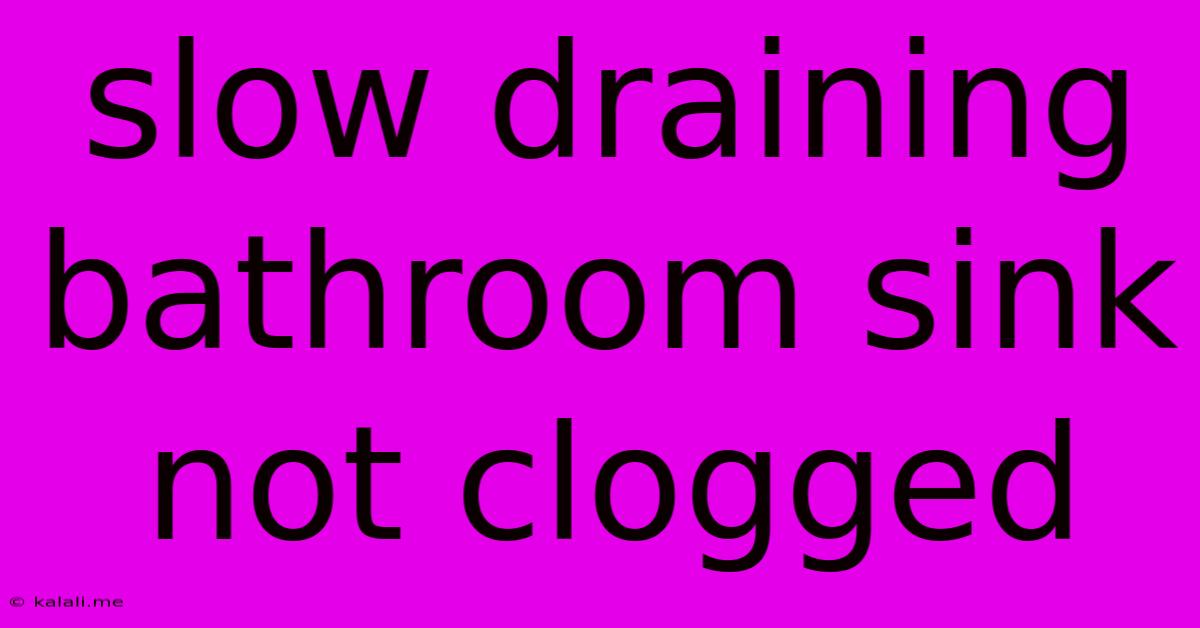Slow Draining Bathroom Sink Not Clogged
Kalali
May 24, 2025 · 3 min read

Table of Contents
Slow Draining Bathroom Sink: Not a Clog, But What Else?
A slow-draining bathroom sink is frustrating, especially when you're sure there's no clog. The water just seems to linger, refusing to rush down the drain. This isn't always a sign of a major plumbing disaster; often, it's a simpler issue that you can troubleshoot yourself. This article explores several common causes of slow-draining bathroom sinks that aren't related to clogs, offering practical solutions and preventative measures.
What Causes a Slow-Draining Sink (Without a Clog)?
Several factors beyond a simple clog can contribute to sluggish drainage in your bathroom sink. Let's investigate the most common culprits:
1. Soap Scum and Residue Buildup
Over time, soap scum, hair products, and other residues can accumulate within the drainpipe, creating a film that restricts water flow. This buildup is particularly common in sinks with older, less-efficient drain systems. This can cause a gradual slowing of the drain over time, rather than a sudden stoppage.
- Solution: Regularly cleaning your sink with a solution of baking soda and vinegar can help prevent this buildup. Pour the mixture down the drain, let it fizz, and then flush with hot water. You might also consider using a drain cleaner designed to break down soap scum, but always follow the manufacturer's instructions carefully.
2. P-Trap Issues
The P-trap is the curved pipe under your sink. Its purpose is to trap debris and prevent sewer gases from entering your home. However, if the P-trap is partially clogged with sediment or if there's a problem with its design, it can restrict water flow. This is different from a complete clog, but it still impacts drainage.
- Solution: Carefully disconnect the P-trap (place a bucket underneath to catch water) and clean it thoroughly. Examine it for any cracks or damage. Reassemble it, ensuring a secure connection.
3. Low Water Pressure
Sometimes, a slow-draining sink isn't a problem with the drain itself but rather with the water supply. Low water pressure can make it appear as though the drain is clogged when, in fact, the water isn't entering the drain quickly enough to facilitate a quick and efficient flush. This is especially noticeable when comparing the draining time to other sinks in your house.
- Solution: Check the water pressure throughout your home. If it's low, contact your water company or a plumber to investigate the issue. It could be a problem with your home's main water line or a blockage in a pipe further up the water system.
4. Vent Problems
The plumbing vent system plays a vital role in preventing sewer backups and ensuring proper drainage. If the vent is clogged or damaged, it can create negative pressure within the drainpipes, slowing water flow. This problem usually affects multiple drains, not just one.
- Solution: Vent issues require professional assessment and repair; attempting to fix a vent problem yourself could cause more serious plumbing complications. Call a plumber to diagnose and address any vent-related problems.
5. Drainpipe Corrosion or Damage
Over time, drainpipes, especially older metal ones, can corrode or become damaged. This internal deterioration can narrow the pipe diameter, leading to slower drainage, even without a visible clog.
- Solution: This issue usually requires professional plumbing assistance and might involve replacing sections of the damaged drainpipe.
Preventative Maintenance for a Smooth-Flowing Sink
Preventing slow drainage is easier than fixing it. Consider these tips:
- Regular Cleaning: Clean your sink and drain regularly with baking soda and vinegar or a commercial cleaner designed for this purpose.
- Hair Strainer: Always use a hair strainer to catch hair and prevent it from entering the drain.
- Avoid Pouring Grease Down the Drain: Grease solidifies in pipes, eventually causing blockages.
- Periodic Inspection: Regularly inspect the P-trap for any signs of buildup or damage.
By understanding the potential causes of a slow-draining bathroom sink beyond simple clogs and taking preventative steps, you can maintain a smoothly functioning plumbing system in your home. Remember, if you're unsure about any repair, it's always best to consult a qualified plumber.
Latest Posts
Latest Posts
-
Word For Choosing Not To Talk
May 24, 2025
-
Car Not Starting No Sound But Lights Work
May 24, 2025
-
After Getting Hit The Target Burns For 1d4 Fire Damage
May 24, 2025
-
Thank You For Your Continuous Support
May 24, 2025
-
How Does A One Half Cent Dividend Payout Work
May 24, 2025
Related Post
Thank you for visiting our website which covers about Slow Draining Bathroom Sink Not Clogged . We hope the information provided has been useful to you. Feel free to contact us if you have any questions or need further assistance. See you next time and don't miss to bookmark.